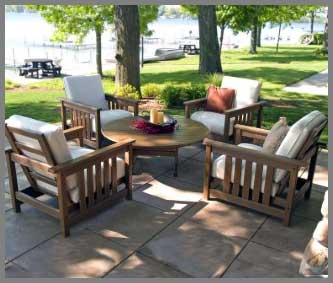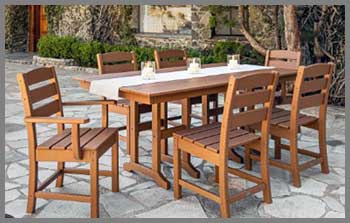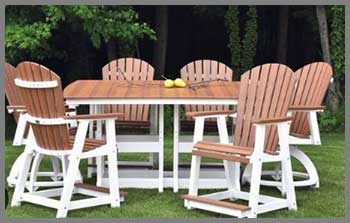
I’ve spent countless hours researching outdoor furniture to transform
my backyard into a cozy retreat, and I’m thrilled to share my insights on Polywood and Berlin Gardens. Both brands promise durability and style, but which one truly delivers for your outdoor space?
In this article, I’ll compare their features, weigh their pros and cons, and share my personal experiences to help you decide.
From maintenance tips to a detailed comparison, I’ll break it all down in a conversational way, so you can confidently choose the perfect furniture for your patio.
Comparison Table: Polywood Vs Berlin Gardens
| Feature | Polywood | Berlin Gardens |
|---|---|---|
| Material | High-density polyethylene (HDPE) from recycled plastics | HDPE with some wood fibers (PolyTuf) |
| Durability | 20-year warranty, resists fading, cracking | 20-year warranty, highly durable |
| Maintenance | Soap and water cleaning, minimal upkeep | Soap and water, occasional deep cleaning |
| Style Options | Wide range, modern to classic | Traditional, Amish-crafted aesthetic |
| Eco-Friendliness | 95% recycled materials | 95% recycled, some virgin HDPE |
| Price | $200-$2,500, budget-friendly | $300-$3,000, premium pricing |
| Weight | Heavier, stable in wind | Lighter, easier to move |
| Comfort | Ergonomic, cushion options | Amish-crafted, high comfort |
My Experience With Polywood
I remember the day my Polywood Adirondack chairs arrived. The vibrant navy blue caught my eye immediately, and I couldn’t wait to set them up on my deck. Assembling them was a breeze—everything came pre-drilled, and the stainless steel hardware felt sturdy.
Sitting in them felt like sinking into a cozy hug, though I noticed they were a bit heavy to move around when I wanted to rearrange my patio. Over the past year, they’ve endured rain, sun, and even a harsh winter without a hint of fading or cracking. Cleaning them is as simple as a quick wipe with soapy water, which is a lifesaver for someone like me who dreads high-maintenance furniture.
What impressed me most was Polywood’s eco-friendly approach. Knowing that my chairs were made from recycled milk jugs made me feel good about my purchase. However, I did find the color options slightly overwhelming—there are so many!
I also noticed that the chairs can get warm in direct sunlight, especially the darker shades. Adding cushions helped, but it’s something to consider if your patio gets full sun. Overall, Polywood’s balance of durability, style, and sustainability has made it a staple in my outdoor setup, though I wish they were a tad lighter for easier rearranging.
Pros Of Polywood
- Durability: Polywood’s HDPE construction is a game-changer. It resists UV rays, rain, and snow, and my chairs still look brand new after a year outdoors. The 20-year warranty gives me peace of mind that they’ll last.
- Low Maintenance: I love that I don’t need to sand, paint, or stain. A quick scrub with soap and water keeps them sparkling, saving me time and effort compared to wood furniture.
- Eco-Friendly: Made from 95% recycled plastics, like milk jugs, Polywood reduces landfill waste. I feel like I’m doing my part for the planet while enjoying stylish furniture.
- Style Versatility: From sleek modern dining sets to classic Adirondack chairs, Polywood offers something for every taste. I found the perfect navy chairs to match my coastal vibe.
- Weather Resistance: These pieces laugh in the face of harsh weather. No cracking, splintering, or fading, even after months of exposure to the elements.
- Affordable Pricing: Compared to premium brands, Polywood’s price range ($200-$2,500) feels reasonable. I got a dining set for under $1,000, which was a steal for the quality.
- Sturdy Build: The furniture is heavy, which means it stays put during windy days. My chairs didn’t budge during a stormy week last summer.
Polywood’s strengths lie in its practicality and sustainability. The brand’s commitment to recycled materials and minimal upkeep makes it ideal for busy homeowners like me who want a hassle-free outdoor setup. The wide range of styles means you can find pieces that fit your aesthetic, whether it’s a sleek bistro set or a cozy glider.
I also appreciate the 20-year warranty—it’s a testament to their confidence in the product’s longevity. For anyone looking for durable, eco-conscious furniture without breaking the bank, Polywood is a solid choice.
Also read: My Thoughts on Floor & Decor Vs. Home Depot
Cons Of Polywood

- Weight: The heft of Polywood furniture can be a double-edged sword. My Adirondack chairs are stable but a pain to move when I want to rearrange my deck.
- Heat Retention: Darker colors absorb heat, making them hot to the touch in direct sunlight. I learned this the hard way when I sat on a black chair in July!
- Limited Traditional Appeal: While Polywood offers classic designs, some pieces feel more modern than rustic. If you love authentic wood grains, you might find the look less organic.
- Initial Cost: Though affordable long-term, the upfront price ($200-$2,500) can feel steep compared to budget wood or metal options, especially for larger sets.
- Assembly Required: Some pieces, like my dining table, required assembly. It wasn’t difficult, but it took about an hour, which might annoy those who want instant setup.
- Color Fading Risk: Though rare, vivid colors may fade slightly over time without UV protectant. I noticed a slight softening in my navy chairs after a year.
Despite these drawbacks, Polywood’s cons are manageable. The weight issue is a trade-off for stability, and cushions or shade can mitigate heat retention. If you’re after a traditional wood aesthetic, you might need to look elsewhere, but for modern durability, Polywood still shines.
The initial cost stings, but the longevity makes it worthwhile. Just be prepared to spend a little time assembling larger pieces and consider lighter colors to avoid heat issues.
Maintenance Tips For Polywood
- Regular Cleaning: Wipe down with soap and water every few months to remove dirt and pollen. I use a soft sponge to avoid scratching the surface.
- Avoid Harsh Chemicals: Stick to mild cleaners. I once used a bleach-based spray, and it dulled the finish slightly—lesson learned!
- Use Covers: During off-seasons, cover your furniture to protect against dust and debris. I got a waterproof cover for my dining set, and it’s kept it pristine.
- Apply UV Protectant: For vibrant colors, apply a UV protectant spray annually. It’s helped maintain the richness of my navy chairs.
- Check Hardware: Inspect stainless steel screws yearly for tightness. I noticed one loose screw on my table after a windy season and tightened it easily.
- Power Washing: Use a power washer under 1,500 psi for deep cleaning. I did this once last summer, and it made my chairs look brand new.
- Store Cushions: If using cushions, store them indoors during harsh weather. Mine got moldy after a wet week, so I now keep them in a shed.
Polywood’s low-maintenance nature is a huge selling point. Regular cleaning with basic soap and water keeps it looking fresh, and covers or UV protectants extend its life. Avoid abrasive cleaners to preserve the finish, and check hardware occasionally to ensure stability. These simple steps have kept my Polywood pieces in top shape, making outdoor upkeep a breeze compared to traditional wood furniture.
My Experience With Berlin Gardens
When I decided to add a dining set to my patio, I chose Berlin Gardens for its reputation for comfort and craftsmanship. The set arrived with a rich wood-grain finish that looked almost like real teak, and the Amish craftsmanship was evident in every detail.
Sitting at the table felt luxurious—the chairs were ergonomic, and the slightly reclined design made long dinners with friends a joy. However, I was surprised at how lightweight the pieces were compared to Polywood, which made rearranging easier but left me worried about stability in strong winds.
Over time, I’ve grown to love Berlin Gardens’ aesthetic. The traditional designs blend seamlessly with my garden’s rustic vibe, and the cushions add an extra layer of comfort. Cleaning is straightforward, but I’ve noticed white pieces require more frequent scrubbing to prevent mildew stains, especially in humid weather.
The premium price tag was a hurdle, but the quality justifies it. My only gripe is that the lighter weight makes me nervous during storms—I’ve had to secure the chairs a few times. Still, Berlin Gardens has elevated my outdoor space with its timeless charm.
Pros Of Berlin Gardens
- Comfort: The Amish-crafted designs prioritize ergonomics. My dining chairs have a slight recline that makes them incredibly comfortable for long meals.
- Aesthetic Appeal: The wood-grain finish mimics real wood beautifully. My set looks like teak, adding a rustic elegance to my patio.
- Durability: Made with PolyTuf HDPE, Berlin Gardens furniture resists cracking and fading. My set has endured a year of harsh weather without issues.
- Lightweight: Compared to Polywood, these pieces are easier to move. I can rearrange my dining set solo, which is a big plus.
- Eco-Friendly: Using 95% recycled materials, Berlin Gardens supports sustainability. I appreciate knowing my furniture helps reduce plastic waste.
- Customization: Offers a range of colors and cushion options. I customized my dining set with navy cushions to match my Polywood chairs.
- Craftsmanship: The attention to detail is impeccable. Every joint and finish on my set feels handcrafted, adding a premium feel.
Berlin Gardens excels in blending comfort with traditional style. The lightweight design makes it versatile for rearranging, and the eco-friendly materials align with my values. The craftsmanship stands out—each piece feels like a work of art. If you’re after furniture that feels luxurious and complements a classic outdoor aesthetic, Berlin Gardens delivers in spades.
Cons Of Berlin Gardens

- Premium Price: Prices ($300-$3,000) are higher than Polywood. My dining set cost nearly $2,000, which felt like a splurge.
- Lightweight Stability: The lighter weight makes pieces less stable in high winds. I’ve had to anchor my chairs during storms.
- Maintenance for White Colors: White pieces show mildew stains more easily. I’ve had to deep-clean my white chairs twice this year.
- Limited Modern Styles: The designs lean traditional, which might not suit modern aesthetics. I wanted a sleeker look but settled for classic.
- Assembly Time: Like Polywood, some pieces require assembly. My dining table took over an hour to put together, which was tedious.
- Less Color Variety: While customizable, the color range is narrower than Polywood’s. I struggled to find the exact shade I wanted.
The higher price and lighter weight are the biggest drawbacks for Berlin Gardens. If you live in a windy area, you’ll need to secure the furniture during storms. The maintenance for white pieces can also be a hassle in humid climates. Still, the comfort and craftsmanship make it worth considering if your budget allows.
Read more: My Thoughts on Houzz Vs. Thumbtack
Maintenance Tips For Berlin Gardens
- Regular Cleaning: Wash with soap and water every few months. I use a soft brush to scrub my dining set gently.
- Use Specific Cleaners: Berlin Gardens recommends Xtreme Clean for regular colors. I found it at Home Depot, and it works wonders.
- Bleach for White Pieces: For white furniture, use a 1:3 bleach-to-water mix to remove mildew. I did this once, and it restored the brightness.
- Cover During Off-Season: Use waterproof covers to protect against debris. I cover my set in winter to keep it pristine.
- Rinse Hardware: Rinse stainless steel hardware with fresh water in coastal areas to prevent corrosion. I do this monthly near the ocean.
- Power Washing: Use a power washer under 1,500 psi for deep cleaning. I tried this on my chairs, and it removed stubborn dirt easily.
- Inspect Joints: Check joints annually for wear. I tightened a loose joint on my table after a year, which was a quick fix.
Berlin Gardens’ maintenance is similar to Polywood’s but requires extra care for white pieces. Using the right cleaners and covering the furniture during harsh weather extends its life. Regular hardware checks ensure durability, especially in coastal areas. These steps have kept my set looking elegant with minimal effort.
Comparison With Other Brands
- Trex: Trex uses composite materials with wood fibers, offering a wood-like look. Its furniture line is smaller than Polywood or Berlin Gardens, but the 20-year warranty matches theirs.
- Seaside Casual: Known for EnviroWood, Seaside Casual uses 100% recycled HDPE, like Polywood. Its coastal durability is impressive, but the style range is narrower than Berlin Gardens.
- LuxCraft: Similar to Berlin Gardens, LuxCraft uses Amish craftsmanship and HDPE. It offers a lifetime warranty, surpassing both brands, but prices are higher.
- Serwall: A budget-friendly option, Serwall uses HDPE and HIPS. It’s less durable than Polywood or Berlin Gardens, with a shorter lifespan of 10-20 years.
- CR Plastics: CR Plastics offers colorful HDPE furniture with a 20-year warranty. It’s comparable to Polywood in price but lacks Berlin Gardens’ premium craftsmanship.
- EC Woods: A newer brand, EC Woods focuses on modern designs with HDPE. Its aesthetic is sleeker than Berlin Gardens but less established than Polywood.
Polywood and Berlin Gardens stand out among competitors for their balance of durability, style, and eco-friendliness. Trex and Seaside Casual are strong contenders for specific aesthetics, while LuxCraft appeals to those prioritizing craftsmanship. Serwall is a budget option but lacks the longevity of the top two. Your choice depends on whether you value Polywood’s affordability or Berlin Gardens’ luxurious feel.
Frequently Asked Questions (FAQ)
Yes, Berlin Gardens is a top-tier brand known for Amish craftsmanship, durability, and comfort, ideal for those seeking premium outdoor furniture.
Polywood can be heavy, retains heat in darker colors, and may require assembly, which can be inconvenient for some users.
Berlin Gardens competes with Polywood, LuxCraft, Trex, Seaside Casual, CR Plastics, and EC Woods in the HDPE furniture market.
Polywood furniture typically lasts 20+ years with proper care, backed by a 20-year warranty, resisting fading, cracking, and weathering.
Conclusion: For Polywood And Berlin Gardens
You’re probably wondering which brand is the right fit for your outdoor space, and I get it—it’s a big decision. Polywood offers unbeatable value, low maintenance, and a wide range of styles that suit modern and classic tastes, making it perfect if you want durability without the fuss.
Berlin Gardens, with its Amish-crafted comfort and elegant designs, is ideal if you’re after a premium, traditional look and don’t mind a higher price tag. Both brands deliver eco-friendly, long-lasting furniture, so your choice hinges on budget, aesthetic, and how much you value lightweight versatility versus stability. Whichever you pick, you’re investing in years of outdoor enjoyment.
